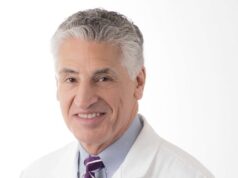A prominent hospital operating on the frontlines of the COVID-19 pandemic in Washington state has released a set of clinical practice guidelines for vascular surgery.
They were put together by Benjamin W. Starnes, MD, professor and chief in the division of vascular surgery at the University of Washington (UW), Seattle, and a larger team of surgeons led by Niten Singh, MD, professor and associate chief, and Jake Hemingway, MD, third-year resident. The city’s Harborview Medical Center, which is managed by UW Medicine, released the guidelines in the face of the “unprecedented” nature of the virus’ impact both on a local level and beyond.
In a commentary published by Vascular Specialist last Friday, Starnes drew attention to the gravity of the COVID-19 situation healthcare professionals were confronting in Washington and elsewhere as the virus spread across the U.S. from its North American epicenter. He issued a call to action, pleading with his fellow service chiefs around the country to take measures immediately in order “conserve our resources and save lives.”
Now come a detailed set of guidelines and accompanying rationale.
“The current situation in other countries suggests that the number of COVID-19 (+) patients requiring hospital and ICU [intensive care unit] care will likely increase over the next two to four weeks, despite social distancing measures,” Starnes and his team warned. “Vascular patients represent a particularly high-risk population and often have multiple serious comorbid conditions that place them at especially high risk of a serious negative outcome if they become infected.
“Compared with other specialties, there are fewer vascular surgeons available to provide care in our community, with an outbreak among our division creating potentially devastating consequences.”
The objectives of the guidelines center on protecting patients, staff and trainees from the virus; preserving resources; providing “the greatest good to the greatest number”; and to support staff and trainees, encouraging wellness among them all.
The Harborview Medical Center guidelines were published as follows:
General guidelines
- All staff and trainees agree to comply with all UW Medicine and Harborview Medical Center COVID-19 specific policies and procedures
- All guidelines are subject to change
- Guidelines effective immediately
Inpatient service
- The inpatient Harborview vascular surgery service will consist of one attending and one vascular surgery trainee (either resident or fellow), with a back-up designated for each (see Table 1) that is available should an exposure occur or if clinical needs require additional support

Table 1 - The rotation schedule is listed in Table 1, with weekly shifts that change Friday morning at 7 a.m.
- Only one provider (either the attending or resident) is expected to see patients on a daily basis. Patients should only be seen if clinically necessary, and no routine rounds should be performed
- Following rounds and morning report, the inpatient resident is expected to physically leave the hospital and respond to patient care issues from home, when appropriate
- The inpatient resident is expected to respond to all inpatient calls and return to the hospital, as needed, when an in-person evaluation is required
- The inpatient trainee is responsible for the coordination and execution of the daily Morning Report, which will occur via Zoom teleconference Monday–Friday
- Overnight, weekend and holiday systems-call scheduling will remain the same.
Outpatient
- All routine in-person follow-up visits and new patient consultations will be cancelled
- All patients will be offered a telemedicine visit, prioritized in the following order:
- New patient consultations for symptomatic carotid artery disease, large (>7cm) abdominal aortic aneurysms (AAAs), chronic limb threatening ischemia (CLTI) with tissue loss
- New patient consultations for CLTI with rest pain but no tissue loss, medium sized AAAs (5.5–7cm)
- Follow-up visits for any patient with chronic limb threatening ischemia or any AAA >5.5cm
- Any new patient consultation or follow-up visit related to dialysis access
- All remaining patients
- The only patients to be seen in clinic are those with surgical wound healing concerns, or those who require staple/suture removal. Patients requiring suture/staple removal will be seen by a single provider. If a provider feels that a patient cannot be managed with telemedicine resources and requires an in-person evaluation, an expeditious clinic visit will be arranged in order to avoid the emergency room
- Clinic will be formally staffed by the weekly on-call attending covering inpatient and outpatient issues
New inpatient/ED vascular surgery consultations
- Vascular surgery will continue to respond to consultations at all times and will continue to be immediately available to help as needed
- In the absence of a surgical emergency (listed below), all consultations will be reviewed by the on-call vascular trainee (resident or fellow) and vascular attending prior to an in-person evaluation of the patient by the trainee. The patient will only be evaluated in-person by the vascular surgery team if deemed necessary by the on-call trainee and attending. Most consultations will not require an in-person evaluation by the vascular team:
- Surgical emergencies requiring immediate in-person evaluation: Ruptured AAA, severe grade blunt aortic injury, arterial hemorrhage, complicated type B aortic dissection with malperfusion, or acute limb ischemia
- In accordance with the COVID-19 specific vascular surgery OR policy, only emergent operative cases will occur. All non-emergent operations will be evaluated on a case-by-case basis, with nearly all being deferred to the outpatient setting
- All documentation will clearly state whether the patient was evaluated in person or not
Vascular surgery procedures/OR utilization guidelines
- The following emergent procedures will be performed: ruptured abdominal aortic aneurysms (see further discussion below), severe grade blunt aortic injuries, complicated type B aortic dissections, and acute limb ischemia depending on resources available
- Other urgent procedures that will be considered based on resources available are symptomatic aneurysms, mycotic aneurysms, wet gangrene, and moderate grade blunt aortic injuries
- No other urgent or elective procedures will be performed
- The Harborview risk score for ruptured abdominal aortic aneurysms should be applied to all patients presenting with ruptured AAA to predict 30-day mortality prior to taking the patient to the operating room (OR). Any patient that falls into the 69% or greater mortality risk will not be offered transfer, and any patient with an 80% or greater mortality risk will not be offered surgery
Transfer guidelines
- Patients should only be transferred to Harborview Medical Center for vascular care if surgery is required, and the procedure qualifies for scheduling as outlined above in the “Vascular surgery procedures/OR utilization guidelines” section
- Patients with uncomplicated type B aortic dissection should not be transferred, and instead should be managed at the local institution with anti-impulse control whenever possible
- Patients with a ruptured AAA and a 69% or greater expected 30-day mortality based on the Harborview risk score (2 or more points) will not be transferred
- Patients who are accepted for transfer to Harborview Medical Center and meet the above listed criteria for an operation should be taken directly to the operating room, bypassing the emergency department (ED)
- Patients who are accepted for transfer to Harborview Medical Center, but do not meet the above listed criteria for an operation, should be taken directly to the ICU or acute care ward, as determined by the vascular surgery attending. No patients should be transferred to the ED for further evaluation
- COVID-19 screening questions will be asked by all accepting physicians
Consulting on COVID-19 patients
- Prior to an in-person evaluation, the consultation will be discussed by the on-call vascular trainee and attending to determine whether an in-person evaluation is required. Telehealth options will be utilized preferentially when available
- If an in-person evaluation is required, the on-call trainee and attending should discuss whether the trainee and attending will examine the patient together, or whether the trainee or attending will examine the patient alone. Only one examination permitted
- If an in-person evaluation is required, the on-call trainee and attending will discuss all of the necessary history and physical exam components that must be obtained during the visit prior to performing the in-person evaluation. This is done in order to minimize the number of encounters required to obtain all of the information:
- The vascular trainee may be required to consent the patient to an operation prior developing a definitive plan with the attending, again in order to minimize encounters
- A list of all required components of the physical exam and history, including necessary supplies and forms, should be created to aid the trainee in remembering the essential components
- When evaluating a COVID-19 (+) patient, or a person under investigation (PUI), the proper sequence for putting on and removing personal protective equipment (PPE) will be followed. The provider evaluating the COVID-19 (+) patient or PUI agrees to notify the assigned nurse prior to entering the room and will ask for assistance in proper donning/doffing of PPE
- No PGY-1 residents will examine a COVID-19 (+) patient or a PUI
- Staff who are pregnant, have chronic medical conditions or who are immunosuppressed will not evaluate any COVID-19 (+) patients or PUIs
Operating on COVID-19 (+) patients
- When operating on a COVID-19 (+) patient, or a PUI, the proper sequence for putting on and removing PPE will be followed
- No PGY-1 residents will operate on a COVID-19 (+) patient or a PUI
- Staff who are pregnant, have chronic medical conditions or who are immunosuppressed will not operate on any COVID-19 (+) patients or PUIs
- The designated COVID-19 OR, if available, will be used for any surgeries being performed on COVID-19 (+) patients or PUIs. The hybrid OR will not be used for these patients unless absolutely necessary
- No surgical staff will be present at the time of intubation, and only one member of the surgical team will be present to position the patient in order to conserve PPE and limit exposures
- Surgical staff agree to don the appropriate PPE, including N95 masks or approve alternatives, while performing any invasive procedures
Resident, fellow and student education
- Daily resident and fellow education will continue during the altered schedule via Zoom teleconference meetings in order to maintain the educational component of residency
- All scheduled didactics will continue to occur via Zoom teleconference meetings at their regularly scheduled times
- No medical students will be permitted to rotate on the Vascular Surgery Service in any clinical capacity
- No clinical observerships will be allowed
Redistribution of service responsibilities
- All vascular surgery trainees agree to being reassigned to other services (ICU, ED, acute care ward) as needed to meet clinical need, as deemed necessary by the graduate medical education (GME) office and vascular surgery program director
- PGY-1 off-service resident schedules and responsibilities will be under the control of the general surgery program
- The vascular surgery division may be asked to admit patients not usually admitted to our service in an attempt to conserve internal medicine resources. For example, patients with diabetic foot infections or cellulitis requiring IV antibiotics
Division meetings
- No in-person division wide meetings permitted
- Division meetings will continue to occur at the regularly scheduled time on a weekly basis
- All division meetings will be held as an “e-conference” using the HIPAA [Health Insurance Portability and Accountability Act]-compliant Zoom teleconference application
- The Zoom teleconference meeting will be run and coordinated by the assigned Harborview Medical Center inpatient resident
- The only staff member permitted in the conference room during the division conference meeting is the assigned inpatient resident
Staff exposure and testing
- For any trainees with a potential exposure to COVID-19 (+) patients, an immediate discussion should occur between the trainee and on-call attending. The trainee should avoid the Regional Vascular Center offices for 48 hours, after which the trainee may return to the office if he/she remains asymptomatic. The trainee should not round on any vascular patients during this time and should instead defer in-person rounding to the on-call attending or backup resident in order to limit the potential spread to other vascular patients
- Staff testing should occur according to UW Medicine guidelines if he/she develop any signs or symptoms of infection
Academic time
- Residents and fellows agree to participate in academic projects during business hours (8 a.m.–5 p.m.) Monday to Friday while not participating in patient care or resident/fellow education












